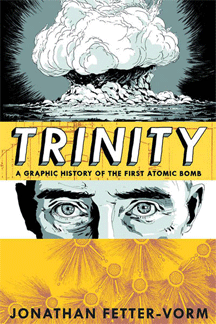By Jay Pasachoff
The sequence and the names—Marie Curie, Rutherford, Fermi, Szilard, Bohr, General Groves, Oppenheimer—are familiar, but the story is interestingly told with well-drawn black-and-white pictures in this “novel graphic.”
The Trinity site itself in New Mexico provides a background for the intercutting of the stories that range from the early work on radioactivity and the atom; through Oppenheimer and Groves setting up secret sites in Chicago, Hanford, Oak Ridge, Berkeley, and Los Alamos; and through the bombing of Japan and the fateful meeting at Yalta. Those who know the story well will enjoy the presentation; those (maybe much too young) who don’t know the story should read it—and it is OK to look at the pictures.
The Los Alamos experiments themselves, the need for openness among scientists amidst the secrecy of the overall site, the saving of Hiroshima for the bomb, and the second-choice selection of Nagasaki are all there. Mutual Assured Distruction and “duck and cover” are there, too. I thought that the treatment of nuclear power, though, was too skimpy and too linked to destructive forces.
I can truly recommend Trinity as a book for all ages.
Astronomer and author Jay Pasachoff is the director of Hopkins Observatory and Field Memorial Professor of Astronomy at Williams College.




